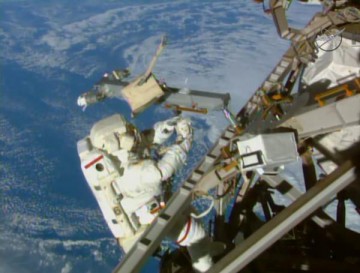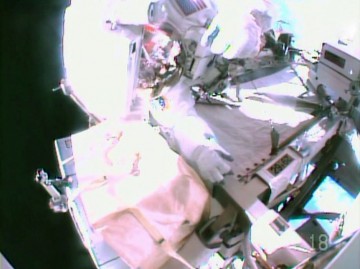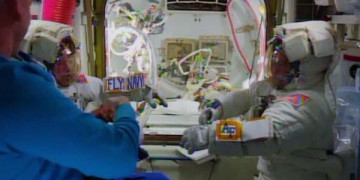
NASA astronauts Terry Virts (EV1) and Barry “Butch” Wilmore (EV2) have completed the third and final spacewalk of Expedition 42, establishing and routing 400 feet (122 meters) of cables for the Common Communications for Visiting Vehicles (C2V2) architecture on the International Space Station (ISS). This now comprises four antennas and three laser reflectors, erected on four supporting booms on the port-side P-3 and starboard-side S-3 trusses, which will provide standardized communications between the station and future visiting vehicles, including Boeing’s CST-100 and SpaceX’s Dragon V-2 piloted craft. The two spacewalkers returned to the station’s Quest airlock at 12:30 p.m. EST, after five hours and 38 minutes of intensive activity. In keeping with their prior EVAs together, Virts and Wilmore stayed well ahead of the timeline, which enabled them to complete one “get-ahead” task in readiness for a busy 2015.
EVA-31 came on the heels of last Saturday’s highly successful EVA-29, during which Wilmore and Virts began the laborious task of laying and configuring 340 feet (103 meters) of cables and utilities on the forward end of the Harmony node and Pressurized Mating Adapter (PMA)-2 to prepare it for the delivery of two International Docking Adapters (IDAs), later this year, and Wednesday’s super-fast EVA-30, in which the spacewalking duo completed the cable work, lubricated the “sticky” Latching End Effector (LEE) of the 57.7-foot-long (17.6-meter) Canadarm2 robotic arm and readied the forward and aft Common Berthing Mechanisms (CBMs) of the Tranquility node for the relocation of the Leonardo Permanent Multipurpose Module (PMM) and the arrival of the Bigelow Expandable Activity Module (BEAM). However, EVA-30 ended on a cautious note, when Virts detected a small quantity of water in his helmet, during the repressurization of the Quest airlock.
The incident garnered unpleasant reminders of the water intrusion incident which engulfed Italian astronaut Luca Parmitano during the curtailed EVA-23, back in July 2013, although it proved to be of far less severity. Virts’ first reference to water came when the repressurization of the airlock reached 5 psi. He noted that its taste ruled out a leakage from his drinking bag and the crew estimated a quantity of about 15 ml. When fellow Expedition 42 crewmate Samantha Cristoforetti removed Virts’ helmet, she became aware that the lower part of his Helmet Absorption Pad (HAP)—one of the corrective actions implemented in the aftermath of the EVA-23 incident and capable of holding up to 800 ml of water—exhibited slight dampness, but at no point were any of the astronauts in any danger.

Following an investigation of the issue, ISS Program managers convened Friday and gave approval for EVA-31 on Sunday. It was pointed out that Virts’ suit (No. 3005) has a history of a condition known as “sublimator water carryover”. This is a small quantity of residual water in the sublimator cooling component which could condense when the environment around the suit is repressurized, following exposure to vacuum during an EVA, and results in a tiny amount of fluid pushing into the helmet. The Mission Management Team (MMT) expressed “a high degree of confidence” that the suit’s systems are in good shape and ready to support EVA-31 and its multitude of objectives.
In keeping with their previous two EVAs, the U.S. Orbital Segment (USOS) team of Virts, Wilmore and Italy’s first woman in space, Samantha Cristoforetti, began preparations for today’s spacewalk in fine fashion and were significantly ahead of the timeline. For EVA-31, the spacewalkers had switched designations, with Virts taking the lead (or “EV1”) role, with red stripes on the legs of his suit, and Wilmore (“EV2”) clad in a pure white ensemble. They undertook 60 minutes of “pre-breathing” on masks, during which time the inner “equipment lock” of the Quest airlock was depressed from its ambient 14.7 psi to 10.2 psi. Upon completion of this well-trodden protocol, the pair donned and purged their suits and the airlock’s atmosphere was repressurized back up to 14.7 psi.
This enabled Virts and Wilmore to enter a nominal pre-breathing regime, lasting 50 minutes, followed by a further 50 minutes of In-Suit Light Exercise (ISLE). The latter was first trialed during the STS-134 shuttle mission in May 2011 and called for the two men to flex their knees for about four minutes, rest for 60 seconds, then repeat until the 50 minutes are up. This technique serves to rapidly remove nitrogen from the bloodstream, thereby avoiding a potentially fatal attack of the “bends”. At length, Cristoforetti transferred the fully-suited pair and their equipment—including the Simplified Aid for EVA Rescue (SAFER) units, affixed to the lower section of their life-sustaining backpacks—from the equipment lock into Quest’s outer “crew lock”. Hatches between the two locks were closed and depressurization got underway at 6:20 a.m. EST. When it reached 5 psi, it briefly halted for pressure and leak checks, then resumed until it achieved a condition of near-vacuum.

Eighteen minutes ahead of schedule, at 6:52 a.m., EVA-31 officially got underway when Virts and Wilmore transferred their suits’ life-support utilities from ISS power onto their internal batteries. Overseeing today’s spacewalk was Flight Director Tony Ceccacci, who fulfilled the same role during last week’s EVA-29, and Art Thomason served as the Lead EVA Officer. Fulfilling the duties of the Lead Capcom was veteran astronaut Suni Williams, the world’s most experienced female spacewalker, who has completed seven career EVAs, totaling 50 hours and 40 minutes. The most recent of Williams’ EVAs took place during her command of Expedition 33, back in November 2012. Assisting Williams at the Capcom’s console was fellow astronaut Mark Vande Hei.
Virts was first to depart Quest, carrying the larger of two antenna booms, known as the “P-3 Boom”. Working from inside the airlock, Wilmore passed out a Large Orbital Replacement Unit (ORU) Bag, carrying four cable reels, then emerged himself a few minutes before 7:10 a.m., bringing the shorter of the two booms, known as the “S-3 Boom”. The pair closed Quest’s thermal cover and pressed into their critical “buddy checks” to ensure that each other’s suits, tethers and tools were in proper order. They confirmed that SAFER handles were down, checked their helmet lights, safety and waist tethers and following a query from Williams about whether Virts’ Wireless Video System (WVS) light was “green”—a call to which Wilmore quickly responded in the affirmative—they were given the go-ahead at 7:15 a.m. to begin their translation to their respective port (Virts) and starboard (Wilmore) worksites on the space station’s expansive truss.
As numerous people across the United States and beyond slept off the effects of their Saturday nights, the two spacewalkers began inching their way across the exterior of the ISS. “Just 2 of numerous government employees at work this Sunday,” NASA tweeted, in the opening minutes of EVA-31, “but with the best view!” Added Chris Hadfield, Canada’s first spacewalker and first ISS Commander: “As 7 billion of us go about our 1st March, 2 of us are clinging to the outside of a spaceship, orbiting Earth.”
To reach his worksite, Virts was required to navigate his way through the “Rat’s Nest”—an area of the central Z-1 truss, which provides a hub for electrical and thermal control utilities and is so named because of its tricky maze of cables—to reach the P-3 truss. Meanwhile, Wilmore headed out to the S-3 truss, which he reached at about 7:30 a.m., and immediately set about installing his booms onto a Worksite Interface (WIF), stowed his bags and attached the antennas. Virts arrived at the P-3 truss a few minutes later and had his booms and both antennas installed by 7:50 a.m.

Both spacewalkers then headed back to the airlock, where Wilmore collected a Large ORU Bag with the four reeled “legs” of cables, each measuring 100 feet (30 meters) in length, and translated out to the U.S. Destiny laboratory module to establish it in close proximity to the Micrometeoroid Orbital Debris (MMOD) shield, under which the C2V2 system would be laid. Working together, the astronauts removed the MMOD shield, temporarily demated a Global Positioning System (GPS) and Ku-band connector, installed the new C2V2 connector and reintegrated them. Working with impressive speed, only about 15 minutes elapsed between the initial removal of the MMOD shield and its replacement. By this stage, Virts and Wilmore were already 50 minutes ahead on the timeline.
Next, Wilmore retrieved two cable reels, passing one to Virts and retaining the other for himself. They routed the port-side “leg” of cables in the first instance, with Virts following the aft translational path along the truss, securing the cables by means of copper wire-ties, as Wilmore followed about 20 feet (6 meters) behind him, routing cables along the forward translational path. This served to separate the two cables by about 18 inches (45 cm), thus protecting the system from the risk of being taken out by an MMOD strike. Wilmore then passed his cable to Virts, who connected it to the antenna at 9:30 a.m. About 15 minutes later, Virts installed the laser reflectors onto the antenna boom, which will be used as ranging aids for future visiting vehicles. Throughout this work, the men captured stunning imagery via their helmet-mounted cameras, with one stunning view taking in the entire port-side forward end of the space station, with Japan’s Kibo laboratory module, its attached Pressurized Logistics Module and the porch-like Exposed Facility.
The astronauts returned to the airlock to return their port-side cable and antenna bags and collect similar bags for the starboard work. Wilmore took the lead for this effort, heading along the aft translational path of the truss, as Virts followed the forward route. Approaching orbital sunrise, the pair paused for standard glove and HAP checks, then moved swiftly into the S-3 task. Wilmore removed two protective caps from the antenna, stowed them and attached his cable to the inboard antenna. Virts then dropped off his reflector bag and Wilmore completed the final C2V2 connections on the outboard antenna. By this point, it was just past 11:20 a.m., about 4.5 hours into EVA-31, and the spacewalkers were now around 90 minutes ahead on the timeline. Installation of the laser reflectors closed out their work and by 11:50 a.m. Wilmore was back at the airlock, ready to receive the ORU bags from Virts.

As noted by Suni Williams in a light-hearted remark, this was the first ISS-based EVA to have been conducted by a pair of former shuttle pilots. Wilmore previously served as pilot on STS-129, back in November 2009, whilst Virts piloted STS-130 in February 2010. With Virts having returned inside Quest, the thermal cover was closed a little after 12:10 p.m. EST and EVA-31 officially ended at 12:30 p.m., after five hours and 38 minutes. Speaking after repressurization, Virts paid tribute to the teams in Mission Control, on-orbit and also in the Neutral Buoyancy Laboratory (NBL) for the training and preparation which enabled the EVAs, as well as offering a nod to the impending 50th anniversary of the first spacewalk, by Soviet cosmonaut Alexei Leonov, way back in March 1965. He expressed amazement that Leonov’s feat had led in a span of just a half-century to the complex, six-hour tasks today conducted to build and maintain the ISS, and highlighted his excitement about where the next half-century of spacewalking may lead humanity.
With the completion of EVA-31, Wilmore has now spent 25 hours and 36 minutes in a pressurized suit, outside the ISS, during four career spacewalks. This elevates him from his current position as the 82nd most experienced spacewalker in the world—out of a grand total of 211 Russian, American, French, German, Japanese, Swiss, Canadian, Swedish, Chinese and Italian men and women—to 58th place, just ahead of Russia’s Mikhail Tyurin and a little behind U.S. astronaut Dan Barry. As for Virts, he has now logged 19 hours and 2 minutes, during three EVAs, which moves him from 115th place to 93rd place, in between fellow ISS residents Carl Walz and Jeff Williams.
Want to keep up-to-date with all things space? Be sure to “Like” AmericaSpace on Facebook and follow us on Twitter: @AmericaSpace




3 Comments
3 Pings & Trackbacks
Pingback:Top Ten US EVA Missions of All Time: No. 10—’The Long and the Short’ « AmericaSpace
Pingback:Top Ten US EVA Missions of All Time: No. 5—’Just Building a Space Station’ « AmericaSpace
Pingback:After 28 Weeks in Orbit, Multi-National Soyuz TMA-15M Crew Returns Safely to Earth « AmericaSpace